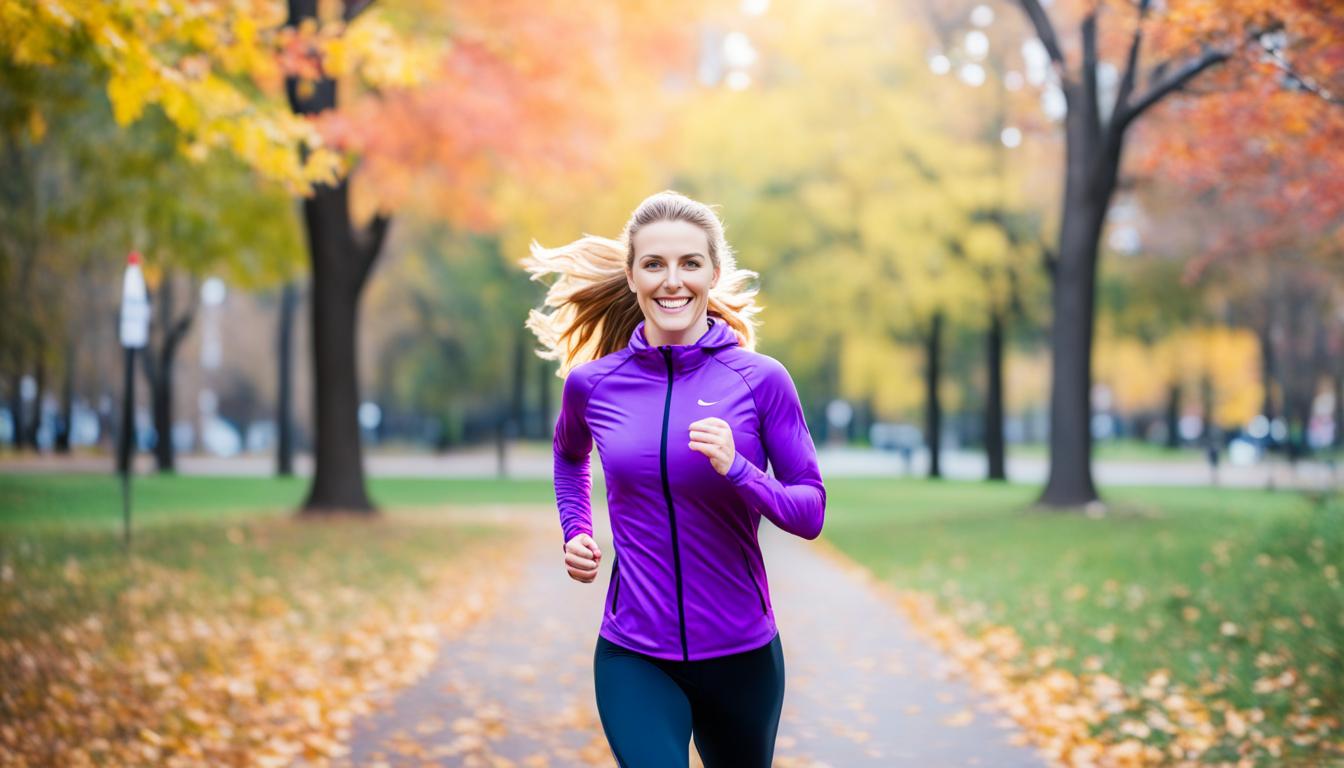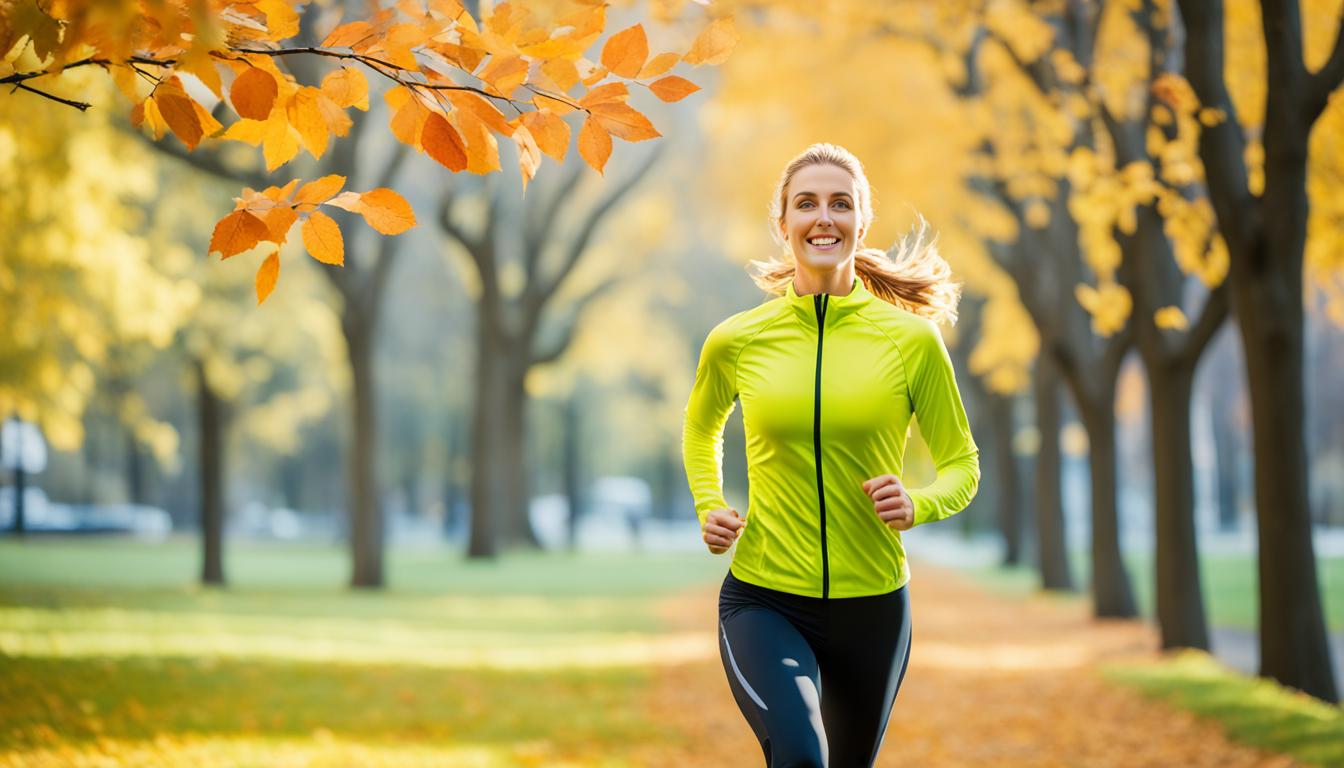Welcome to your go-to guide on how to embrace Climate-Smart Fitness! It’s crucial to keep up with active habits all year for your health. Adjusting your fitness routine to match the weather can significantly improve your experience and results. Whether you’re facing extreme heat, heavy humidity, or cold, knowing how to stay active in different conditions is key.
This article will provide you with essential fitness tips for various temperatures. These strategies ensure your workouts are safe and enjoyable, regardless of the climate. We’ll cover adapting workouts to seasonal changes and offer insights on hydration. Discover how to incorporate these climate-smart practices into your life and stay fit all year. For budget-friendly fitness tips, check out this guide here.
Key Takeaways
- Adapting workouts to different weather conditions is essential for effective exercise.
- Hydration is key, especially in hot temperatures—drink before and during your workouts.
- Choose suitable clothing and timing for exercising outdoors in varying climates.
- Understanding humidity levels can impact your workout efficiency and safety.
- Regular acclimatization to heat can enhance performance in warmer conditions.
Understanding the Importance of Climate-Smart Fitness
Adopting climate-smart fitness significantly boosts your health. It involves tailoring your workouts to the environment, ensuring safety while reaping exercise’s broad benefits across climates. In Australia, 70% of adults are inactive, leading to obesity and heart diseases. Recognizing how climate impacts your exercise helps you make better choices about staying active.
The advantages of exercising in diverse climates are significant. It enhances heart health and aids mental well-being by lowering anxiety and elevating mood. With temperatures soaring, especially in Australia, selecting the right fitness plans for varying climates is crucial. Knowing that peak activity is around 28 degrees Celsius helps tailor workouts to the weather.
Climate change brings new challenges, like more extreme heat days. Sports organizations highlight the dangers of heat-related illnesses during heatwaves. By incorporating climate-smart fitness, you’re better equipped to handle rising UV levels and air pollution, ensuring your health as you achieve your fitness goals.
Fitness for Different Climates
Adapting your workouts to varying climates is key to keeping up with your fitness goals year-round. With millions of people facing extreme temperature changes, it’s vital to adjust your exercise plans accordingly. In hot months, you might need to modify your activities to avoid heat-related injuries. Conversely, in cold weather, you must employ specific strategies to remain safe and active.
Adjusting Your Workouts According to Climate
When temperatures soar above 85 °F (29 °C), it’s time to rethink your exercise routine. High-intensity workouts during these hours can lead to overheating and hyperthermia, with body temperatures soaring past 102.2 °F (39 °C). Consider switching to moderate-intensity exercises or exercising during cooler parts of the day instead.
In contrast, colder months can see temperatures drop to 25 °F (-4 °C), increasing the risk of hypothermia if your body temperature falls below 96.5 °F (35.8 °C). Dressing in layers and being aware of wind chill effects can keep you safe while exercising in the cold.
Benefits of Being Active in Different Weather Conditions
Physical activity in various weather conditions not only boosts health but also offers unique benefits by season. For example, exercising outdoors in cooler months can boost metabolism, aiding in weight management. Summer workouts provide excellent opportunities for cardiovascular health improvements, making them ideal for enjoying the outdoors.
The pleasure derived from outdoor activities significantly enhances your dedication to fitness. It motivates you to continue with your routines, even when the climate poses challenges.
Staying Active in Hot Weather
Hot weather brings unique challenges for staying active. Strategic planning is essential. Timing your workouts and staying hydrated are key. These tips ensure your exercise routine remains safe and enjoyable.
Timing Your Outdoor Activities
To stay comfortable and safe, avoid exercising between noon and 3 p.m. when temperatures are highest. Early mornings or evenings offer cooler temperatures for your activities. Use shaded routes or indoor spaces during the hottest hours to keep your routine consistent.
Hydration Strategies in High Temperatures
Hydration is vital when exercising in the heat. Drink water before, during, and after your workouts to prevent dehydration. For activities over an hour, consider sports drinks to replenish electrolytes. Aim for half a liter to a liter of fluids per hour of exercise.
Watch for signs of overheating like heavy sweating or muscle cramps. Be aware of these signs, especially if your medications affect your heat response. This awareness keeps you safe while enjoying your workouts. For more tips on staying fit in different temperatures, visit this helpful resource.
Workout Routines for Various Climates
Adapting your workout routines for different climates is crucial for maintaining fitness. Engaging in exercises suitable for hot weather can significantly impact your performance. Activities that keep you refreshed and energized help you stay committed to your fitness goals, regardless of the temperature.
Heat-Friendly Exercises You Can Try
In warm conditions, certain exercises are particularly effective and enjoyable. Swimming is a standout, burning 270 to 385 calories in 30 minutes, depending on intensity. It’s low-impact, making it suitable for various fitness levels. Walking in shaded areas or hiking are also excellent choices; a 170-pound person can burn about 693 calories in 90 minutes.
Outdoor games like tennis or casual soccer offer a fun way to work out, burning up to 616 or 460 to 540 calories per hour, respectively.
Indoor Alternatives When It’s Too Hot
On extremely hot days, switching to indoor workouts can help you stay active safely. Gyms and group classes provide a climate-controlled environment for effective workouts. Home workouts, such as HIIT sessions, are also beneficial, burning fat efficiently while fitting into a busy schedule.
Explore online resources to customize your routine based on your preferences. For more ideas on effective winter fitness routines, check out this informative link.
Dealing with Humidity During Outdoor Exercise
Outdoor exercise comes with its own set of challenges, particularly when humidity is high. It’s crucial to grasp how humidity impacts your body during workouts. This knowledge is key to maintaining performance and ensuring safety.
Understanding Humidity’s Effects on Your Body
Humidity significantly alters how your body responds to exercise. When humidity exceeds 40%, sweat evaporation, crucial for heat loss, is impaired. This makes it harder to cool down, leading to an increased perceived temperature. This phenomenon, known as the Heat Index, can severely impact your performance.
Staying Cool in High Humidity
To stay cool in humid conditions, focus on hydration and strategic exercise planning. Boost your fluid intake before, during, and after workouts. Utilizing cooling towels or taking breaks in shaded areas can also help manage your body temperature. If conditions become too severe, consider adjusting your exercise plan or reducing workout duration to prevent overheating. Always monitor humidity and temperature levels to guarantee a safe and effective workout.
Adapting Your Workouts to Different Seasons
As seasons transition, so must your fitness regimen. It’s crucial to adapt workouts seasonally to keep motivation high and routines effective. Developing strategies tailored to each season’s unique challenges and benefits is key. Whether it’s leveraging longer summer days for outdoor activities or opting for indoor routines in winter, a proactive approach significantly enhances your fitness journey.
Seasonal Workout Strategies
Spring and summer are prime times for outdoor fitness. Activities like hiking, cycling, and jogging become more enjoyable with warmer weather. Conversely, winter calls for indoor alternatives such as yoga or spin cycling. Balancing your activities ensures consistent fitness, preventing the motivation slump often associated with colder weather and shorter days.
How to Transition Between Different Climates
Adapting to climate changes requires small tweaks to your routine. Adjust workout intensity or duration according to temperature fluctuations. Wearing layers on cooler days not only keeps you comfortable but also allows for easy temperature regulation during exercise. Having waterproof gear makes rainy days more manageable, ensuring you stick to your fitness goals.

Staying Healthy in Cold Weather
Cold weather can challenge your fitness routine, but proper preparation helps you stay healthy. To enjoy outdoor workouts in winter, you need more than just determination. A well-thought-out plan keeps you active, energized, and safe.
Preparing for Your Cold Weather Workouts
Before venturing into the cold, preparing for winter workouts is crucial. Begin with a dynamic warm-up to prepare your muscles. It’s important to wear layers: start with a synthetic layer that wicks away moisture, add fleece or wool for insulation, and end with a waterproof outer layer. This combination helps you regulate your body temperature effectively, especially as you heat up from exercise.
Hydration is key in cold weather, even if you don’t feel as thirsty. Drinking water before, during, and after your workout is essential. Staying hydrated enhances your performance and supports your immune system, crucial during flu season.
Choosing the Right Gear for Winter Activities
Choosing the right gear for cold weather workouts is crucial. If you exercise in low light, wear reflective clothing. This keeps you warm and ensures you’re visible as daylight shortens in winter.
Be aware of frostbite and hypothermia symptoms like numbness and intense shivering. Listen to your body. If the cold feels too extreme, adjust your routine or move indoors. Always have a backup plan to keep your exercise consistent, regardless of the weather.
Training in Diverse Weather Conditions
Outdoor workouts come with unique challenges based on the weather. It’s crucial to adapt your training to ensure you can maintain your fitness goals throughout the year. Knowing how to handle adverse weather conditions is key to staying safe and enjoying your workouts.
Best Practices for Adverse Weather Conditions
Always check the weather forecast before stepping out. Be alert for signs of heat stress like excessive sweating and fatigue. If you notice shivering or numbness in your extremities, it’s time to find shelter.
Adjusting your workout schedule is essential. Choose early morning or late evening sessions when it’s hot to dodge the peak heat. In cold weather, wear layers to stay warm and flexible. Also, modify your hydration plan to keep up with your body’s needs, regardless of the weather. These strategies help you stay fit and safe while training in various weather conditions.
Outdoor Fitness in Rainy Weather
Rain shouldn’t stop you from keeping up with your fitness goals. Embracing outdoor fitness in the rain can be both fun and beneficial for your health. Invest in gear designed for wet conditions, such as water-resistant clothing and shoes with good traction. This ensures you can exercise safely while staying dry.
Activities that utilize the rainy day can make your workouts more engaging. Agility drills in puddles, for instance, add an exciting twist to your routine, enhancing your overall experience.
Making the Most of Your Rainy Day Workouts
Rainy days offer unique opportunities to spice up your workout routine. Many find that *exercising in the rain* boosts their motivation. It keeps you active and provides a refreshing change in your environment.
Engaging with nature during light rain can uplift your mood and keep you on track with your fitness goals. Rain can transform your workout atmosphere, helping you break free from the routine of standard exercises.

Safety Precautions for Exercising in the Rain
When it comes to *safe exercising in the rain*, it’s crucial to take precautions. Wet surfaces can be slippery, increasing the risk of falls. Be cautious of your surroundings and avoid dangerous areas.
Wearing the right footwear is essential. A pair of shoes with excellent grip will help you navigate through the moisture safely. Always pay attention to your body and head indoors if conditions become too hazardous.
Maintaining Your Routine During Climate Changes
As climate conditions evolve, it’s crucial to maintain fitness during these changes for your overall health. Creating effective exercise plans helps you stay active, ensuring your fitness journey remains on track. It’s vital to adapt workouts for climate changes, allowing you to efficiently adjust to varying weather conditions.
Identifying Effective Exercise Plans for Changing Weather
Regularly assessing climate projections allows you to thoughtfully modify your routines. Use technology, such as weather apps, to stay informed. Planning workouts around temperature changes and potential weather events boosts your ability to adhere to effective exercise plans. Moreover, consider how climate affects your body; rising air pollution levels can impact lung function, influencing your workout choices.

Recognizing changes in pollen concentrations and seasons helps in adapting workouts for climate changes. For example, high pollen days might necessitate indoor workouts to protect your health. Flexibility in adjusting your exercise routine keeps you consistent while adapting to environmental shifts. Emphasizing *versatility* in your workout strategy ensures you can continue exercising despite changing conditions.
Tips for Adapting Your Mindset Towards Climate-Smart Fitness
Adopting a climate-smart fitness mindset means changing how you view outdoor workouts. Acknowledge that the weather will vary and affect your routine. Instead of seeing these changes as obstacles, see them as chances to grow. Developing a flexible mindset for fitness equips you to overcome environmental hurdles with confidence and creativity.
Setting realistic fitness goals that are flexible is key to adapting. This mindset keeps you active no matter the weather, helping you enjoy the journey. Using psychological strategies for outdoor workouts boosts your motivation in tough weather. Joining community discussions offers inspiration, building a support network that bolsters resilience.
Each season brings new opportunities for your fitness path. By welcoming the elements, you build a robust adapting mindset for fitness. This outlook improves your physical abilities and enriches your overall health. For more advice on keeping up your fitness routine in varying weather, check out this valuable resource on fitness and heart health.
Conclusion
Climate-smart fitness plays a pivotal role in maintaining health as the environment changes. With 31.1% of adults globally inactive, adapting fitness routines is crucial. It impacts both physical and mental health.
Strategies that allow physical activity in various weather conditions offer numerous benefits. Engaging in outdoor activities boosts mood and improves health. Adapting fitness to climate changes helps maintain exercise consistency despite environmental impacts.
Climate change presents ongoing challenges, making a commitment to climate-smart fitness vital. It’s not just about personal health but also community wellness. By staying active, you contribute to better health for everyone.
FAQ
What is climate-smart fitness?
How can I stay active during hot weather?
What should I do if it’s too humid to exercise outdoors?
How do seasonal changes affect my workout routine?
What gear do I need for cold weather workouts?
Can I still work out in the rain?
How can I prepare for adverse weather conditions?
What are some effective hydration strategies for exercising in the heat?
How can I cultivate a positive mindset for climate-smart fitness?
Source Links
- Microsoft Word – ExHt_SM.doc – https://www.ucdenver.edu/docs/librariesprovider65/clinical-services/sports-medicine/workout-tips-for-exercise-in-the-heat.pdf?sfvrsn=9a345bb9_2
- How to Make Exercising Outside in Hot Weather Feel a Little Less Miserable – https://www.self.com/story/hot-workout-outdoor-tips
- How to exercise safely in the heat – https://www.npr.org/sections/health-shots/2021/07/19/1016989389/how-to-heat-proof-your-summer-workout
- How climate change could affect the way we exercise – https://www.smh.com.au/lifestyle/health-and-wellness/climate-change-could-affect-the-way-we-exercise-20170425-gvrt96.html
- Physical Activity, Climate Change and Health—A Conceptual Model for Planning Public Health Action at the Organizational Level – https://www.ncbi.nlm.nih.gov/pmc/articles/PMC9025182/
- Weather repetitions and climate fitness – http://www.climate.gov/news-features/blogs/enso/weather-repetitions-and-climate-fitness
- PDF – https://www.acsm.org/docs/default-source/files-for-resource-library/exercising-hot-cold-environments.pdf?sfvrsn=1b06c972_4
- The impact of weather on summer and winter exercise behaviors – https://www.ncbi.nlm.nih.gov/pmc/articles/PMC6349565/
- How to Be Active Safely in Warm Weather – https://www.heart.org/en/healthy-living/fitness/getting-active/how-to-stay-active-in-warm-weather
- Exercise Safely in Hot Weather – https://www.eatright.org/fitness/physical-activity/exercise-nutrition/exercise-safely-in-hot-weather
- 13 Outdoor Workouts to Add Fun and Variety to Your Routine – https://www.healthline.com/nutrition/outdoor-workout-ideas
- 10 Outdoor Workout Ideas: Stay Active in Beautiful Weather – https://mitchellholistichealth.com/10-outdoor-workout-ideas-for-enjoying-beautiful-weather/
- How humidity affects hydration, endurance and performance – https://www.precisionhydration.com/performance-advice/hydration/humidity-hydration-performance/
- Tips for Running in Heat and Humidity – https://livablebuckhead.com/tips-for-running-in-heat-and-humidity/
- Adapting physical activity to beat the seasonal weather | Xyla Services – https://xylaservices.com/professionals/news/adapting-physical-activity-to-beat-the-seasonal-weather/
- Seasonal Fitness: Adapting Exercise Routines for Year-Round Health – Lexicon – https://www.lexiconin.com/47/seasonal-fitness-adapting-exercise-routines-for-year-round-health/
- 6 Signs it’s Time to Switch Up Your Workout – https://www.acefitness.org/resources/everyone/blog/4984/6-signs-it-s-time-to-switch-up-your-workout/
- 7 tips to stay safe when exercising in the cold – https://ukhealthcare.uky.edu/wellness-community/blog/7-tips-stay-safe-when-exercising-cold
- How to Stay Active in Cold Weather – https://www.heart.org/en/healthy-living/fitness/getting-active/how-to-stay-active-in-cold-weather
- How to Stay Active Outside When the Weather Gets Colder – https://health.clevelandclinic.org/how-to-stay-active-outside-when-the-weather-gets-colder
- Training in different climates – https://www.tomfieldinggolf.net/training-in-different-climates.html
- Consensus recommendations on training and competing in the heat – https://www.ncbi.nlm.nih.gov/pmc/articles/PMC4602249/
- Training for a warm race? Here’s who might have an advantage. – https://www.washingtonpost.com/climate-environment/2023/05/10/marathon-triathlon-ironman-training-warm-climate/
- How to Safely Exercise Outdoors in Various Weather Conditions – https://www.opticweather.com/blog/how-to-safely-exercise-outdoors-in-various-weather-conditions
- Working Out at the Gym vs. Outdoors – Fitness Project – https://fitnessproject.us/blog/working-out-at-the-gym-vs-outdoors/
- 3 Ways Climate Change Can Affect Your Fitness Routine – SilverSneakers – https://www.silversneakers.com/blog/3-ways-climate-change-can-affect-your-fitness-routine/
- How to Work Out Outside in the Winter – https://www.everydayhealth.com/healthy-living/fitness/easy-winter-exercise-tips-help-you-stay-fit/
- Ten key requirements for a systemic approach to climate adaptation – https://www.mckinsey.com/capabilities/sustainability/our-insights/ten-key-requirements-for-a-systemic-approach-to-climate-adaptation
- PDF – https://coast.noaa.gov/data/czm/media/adaptationguide.pdf
- The great outdoors: how a green exercise environment can benefit all – https://www.ncbi.nlm.nih.gov/pmc/articles/PMC3710158/
- Human Biological Adaptability: Adapting to Climate Extremes – https://www.palomar.edu/anthro/adapt/adapt_2.htm
- 8 Conclusions and Recommendations | Adapting to the Impacts of Climate Change – https://nap.nationalacademies.org/read/12783/chapter/10


